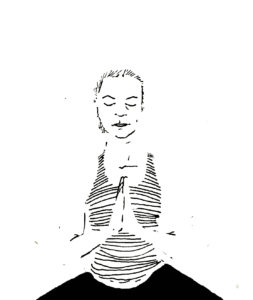
yogas chitta vritti nirodha – “Yoga is the removal of the fluctuations of the mind”
The first text to define and enunciate Yoga as a philosophical doctrine is more than 2,000 years old and is attributed to an Indian sage, philosopher, physicist and grammarian named Patanjali.
The Yoga Sutras are 196 aphorisms that count more than 20,000 translations and interpretations given the incredible richness of meaning that characterizes their original language, Sanskrit. However, once a valid interpretation guide of the Sutras has been chosen (I now have in my hands Yoga Sutra of Patanjali, talks by Dr. Jayadeva Yogendra & Smt. Hansaji, The Yoga Institute) these are incredibly beautiful to read and easy to remember . It is not by chance their definition as slokas, the Sanskrit root of the English word “slogan”, implying a vast meaning in few words.
The purpose of the Sutras is to indicate the steps to reach the final state of Yoga, or Samadhi. The phrases composing them, made of few words, seem to have a life of their own, as well as their own strength and weight. They know how to pop up at the right moment once they have been recorded in our memories, like good counselors that we can count on whenever we need clarity.
With this inestimable thousand-year treasure within our reach, it is worth dedicating a little attention to this text.
Patanjali’s second Sutra covers all the meaning of practice: “Yoga is the removal of the fluctuations of the mind” or in Sanskrit yogas chitta vritti nirodha.
According to Punditji, my teacher, Patanjali wanted to start by giving us a clue as to what the goal would be, before guiding us step by step down the long road towards it (thank goodness), and Yoga is both the path and the final goal.
Why calming the fluctuations of the mind would be our goal? What does it mean to attain full consciousness?
It is proven that meditative practices produce neurobiological changes that reduce anxiety, as well as behaviors related to fear, anger, depression and negative associations; we become less unhappy. Instead, they stimulate our attention and positive associations; we become happier. Meditating produces a greater flow of blood to the pre-frontal cortex, which activates the executive functions, the decision making, the resolutive attitude; we get to know better what we want. Meditating also increases the level of some neurotransmitters and hormones, among others serotonin (mood control), dopamine (control of social phobia), melatonin during sleep (deep sleep), with the result of stabilizing the mind; we become more lucid. Another proven benefit of meditation is that it triggers the growth of new neurons (neurogenesis) and generates new connections between existing neurons (synaptogenesis); we take full advantage of our intelligence.
There is much more, these data only serve to confirm what our ancestors, with their own bodies as their only tool for research, already were very clear with. Some keys are in the analysis of Patanjali’s words:
Yogas (of Yoga). The word is synonymous of Samadhi: spiritual perfection and union with the absolute. It also encompasses the meaning of “mastery of the body,” “perfect stillness of the mind,” “intrinsic ability of the mind to be concentrated.” It is about being in our center, the essence that we all have and that, in all, is good.
Chitta means “what gathers” and alludes to our mind but also to the ego, to the senses, to the voluntary actions, and to the pranas (the 5 types of bio-energy). Chitta is like a container of feelings, thoughts, ideas, which are what defines the human mind. Without thoughts, the mind does not exist. We are continuously collecting information, storing it, modifying it, creating new information. Chitta is a vast warehouse and is constantly in action. We identify with both our positive and negative feelings so deeply, that we cannot observe them at a distance, and their constant presence takes away our calmness, generates stress and obfuscates our purest and most real vision, our focused vision.
Vrittis are the activities that occupy our mind and are divided between true knowledge, wrong knowledge, imagination, dream, memory. We are almost always engaged in some of these activities, and these are the ones we can learn to control through Yoga. Vrittis translates into “modifications of the mind”, but the word also alludes to rotation, suggesting a movement. Very true. Emotions, memories, assumptions rotate and move without stopping inside the mind, especially when we try to stop them. They can take us away from our center.
Nirodha is the complete absence of thoughts, that is to say, to lead the mind not to think. The word also refers to restriction, control or domain, and a self-training process. That is, there is work to be done to achieve this goal.
By practicing Yoga we offer a moment of rest to Chitta, calming the Vrittis and bringing the mind to a state of rest, Nirodha. In this way we are creating a space to indentify with something other than our little “I”, the bliss “full consciousness”.
Yogi masters, who love metaphors very much, compare it with the ability to calm the surface of a restless lake so that we can see all the way to the bottom. The act of training ourselves to observe our thoughts and stop the fluctuations of the mind (or the flow of consciousness) allows us to see that consciousness itself is our true nature and that the ephemeral noise of thoughts, feelings and sensations is not real or significant .
The method indicated by Patanjali, called Yoga, “is both the means and the goal” (B.K.S. Iyengar).
And the good news is that the only necessary tool to get there is our own body.

